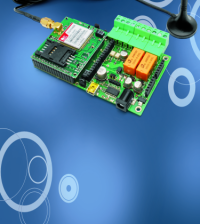- Building a 3D Digital Clock with ArduinoPosted 3 months ago
- Creating a controller for Minecraft with realistic body movements using ArduinoPosted 4 months ago
- Snowflake with ArduinoPosted 4 months ago
- Holographic Christmas TreePosted 5 months ago
- Segstick: Build Your Own Self-Balancing Vehicle in Just 2 Days with ArduinoPosted 5 months ago
- ZSWatch: An Open-Source Smartwatch Project Based on the Zephyr Operating SystemPosted 6 months ago
- What is IoT and which devices to usePosted 6 months ago
- Maker Faire Rome Unveils Thrilling “Padel Smash Future” Pavilion for Sports EnthusiastsPosted 7 months ago
- Make your curtains smartPosted 7 months ago
- Configuring an ESP8266 for Battery PowerPosted 7 months ago
GSM Remote Control – 2 IN and 2 OUT DTMF
Part 1 – Introduction
Excellent to remotely control via GSM the activation of engines, lightening or watering systems and alarm systems. It sends commands through SMS as well as with DTMF dual tones and allows you to check if they were successful.
In this post we present the last application created from the development of the modular remote control we started describing in the issue of April: this is a remote control with 2 inputs and 2 outputs, special because in addition to receiving SMS commands, as the other three devices described, it is also prepared to identify the standard dual tones that all mobiles and modern phones generate and send through the voice channel when we dial a number. This new remote can, therefore, be commanded calling its number, waiting for the reply and pressing the buttons on the keypad, each of the corresponding to a specific function; for security reasons, it accepts calls coming only from a reduced group of numbers (only 8 numbers) that you need to store in a list (list of enabled numbers) before being operative. The commands that can be sent concern the management of output relays as well as the reading of the status of the inputs and some operation settings.
The circuit remotely allows to manage two users or to check the state of several units via SMS or DTMF keypad tones.

How it works
The device described below has two main functions: the first one is to remotely control electric, electronic, or electrically managed units; the second one is to remotely acquire electrical conditions, i.e. the status of sensors and any kind of device whose situation can be expressed through a logical level or a voltage value. For the first function there is a rich set of commands to send via SMS, following the syntax described in the due table and described (for those regarding the DTMF tones) here, (the rest of them are the same we described for the remote control 2 IN/2 OUT published a couple of months ago). Specifically, the instructions allow the user to: enable or disable each of the present outputs, by impulses (defining, within the limits, the activation time) and in bistable mode; interrogate the unit to obtain the status of one of these outputs. This last function is critical when the user has forgotten the last sent command i.e. to be sure a SMS command has had the desired effect; regarding the dual tone command, the confirmation immediately arrives with an acoustic signal to the receiver of the phone used to make the call. Through an appropriate message, our remote allows you to establish whether, in case of black-out, it has to keep in memory the pre black-out condition and reestablish it when power is restored; useful to avoid that, in case of accidental switching, when the unit is started the relays lose the settings given by the user via remote commands sent with a mobile through DTMF or SMS.
Regarding the functions of the inputs, we have set commands used to know, any time, the condition of one or both of them; there is also a remote alarm, that is the generation of SMS and calls to the numbers in the list, upon the presence of a given condition, this is also to be set with SMS commands. The inputs detect the presence (over 3 V) or absence of tension, the situation that triggers the alarm and the sequence of messages and calls can be defined as desired: the remote control can consider as an alarm the presence, absence or change of status.
Note that the call does not require a reply: it is just a couple of rings sent to the called phone.
All query commands (intended for outputs or inputs) determine that the system sends a SMS, with the requested data, to the phone number (if it can be identified) that sent the commands. By means of the DTMF command the remote immediately replies with acoustic notes, helping you save on the cost of the messages. For every condition that provides for the transmission of unsolicited messages manually, i.e. those regarding the remote alarm functioning (change in input status, interruption and reestablishing of power, circuit start-up), the remote allows you to define the text sent to the eight numbers in the list of people to be warned.















